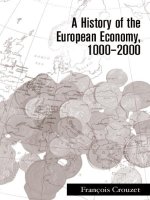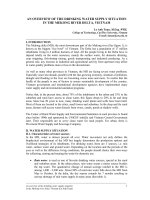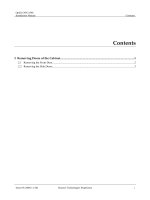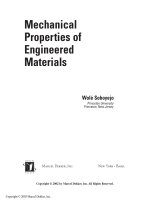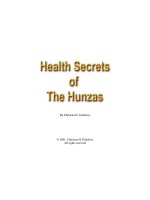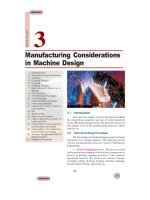Tài liệu Multimedia Applications Of The Wavelet Transform ppt
Bạn đang xem bản rút gọn của tài liệu. Xem và tải ngay bản đầy đủ của tài liệu tại đây (3.62 MB, 240 trang )
Multimedia Applications
of the Wavelet Transform
Inauguraldissertation zur Erlangung
des akademischen Grades eines
Doktors der Naturwissenschaften
der Universit
¨
at Mannheim
vorgelegt von
Dipl.–Math. oec. Claudia Kerstin Schremmer
aus Detmold
Mannheim, 2001
Dekan: Professor Dr. Herbert Popp, Universit¨at Mannheim
Referent: Professor Dr. Wolfgang Effelsberg, Universit¨at Mannheim
Korreferent: Professor Dr. Gabriele Steidl, Universit¨at Mannheim
Tag der m ¨undlichen Pr¨ufung: 08. Februar 2002
If we knew what we were doing,
it would not be called research, would it?
— Albert Einstein
Abstract
This dissertation investigates novel applications of the wavelet transform in the analysis and compres-
sion of audio, still images, and video. In a second focal point, we evaluate the didactic potential of
multimedia–enhanced teaching material for higher education.
Most recently, some theoretical surveys have been published on the potential for a wavelet–based
restoration of noisy audio signals. Based on these, we have developed a wavelet–based denoising
program for audio signals that allows flexible parameter settings. It is suited for the demonstration of
the potential of wavelet–based denoising algorithms as well as for use in teaching.
The multiscale property of the wavelet transform can successfully be exploited for the detection of
semantic structures in still images. For example, a comparison of the coefficients in the transformed
domain allows the analysis and extraction of a predominant structure. This idea forms the basis of
our semiautomatic edge detection algorithm that was developed during the present work. A number
of empirical evaluations of potential parameter settings for the convolution–based wavelet transform
and the resulting recommendations follow.
In the context of the teleteaching project Virtuelle Hochschule Oberrhein, i.e., Virtual University of
the Upper Rhine Valley (VIROR), which aims to establish a semi–virtual university, many lectures and
seminars were transmitted between remote locations. We thus encountered the problem of scalability
of a video stream for different access bandwidths in the Internet. A substantial contribution of this
dissertation is the introduction of the wavelet transform into hierarchical video coding and the recom-
mendation of parameter settings based on empirical surveys. Furthermore, a prototype implementa-
tion of a hierarchical client–server video program proves the principal feasibility of a wavelet–based,
nearly arbitrarily scalable application.
Mathematical transformations of digital signals constitute a commonly underestimated problem for
students in their first semesters of study. Motivated by the VIROR project, we spent a considerable
amount of time and effort on the exploration of approaches to enhance mathematical topics with
multimedia; both the technical design and the didactic integration into the curriculum are discussed. In
a large field trial on traditional teaching versus multimedia–enhanced teaching, in which the students
were assigned to different learning settings, not only the motivation, but the objective knowledge
gained by the students was measured. This allows us to objectively rate positive the efficiency of the
teaching modules developed in the scope of this dissertation.
II
A
BSTRACT
Kurzfassung
Die vorliegende Dissertation untersucht neue Einsatzm ¨oglichkeiten der Wavelet–Transformation f¨ur
die Analyse und Kompression der multimedialen Anwendungen Audio, Standbild und Video. In
einem weiteren Schwerpunkt evaluieren wir das didaktische Potential multimedial angereicherten
Lehrmaterials f¨ur die universit¨are Lehre.
In j¨ungster Zeit sind einige theoretische Arbeiten ¨uber Wavelet–basierte Restaurationsverfahren von
verrauschten Audiosignalen ver¨offentlicht worden. Hierauf aufbauend haben wir ein Wavelet–
basiertes Entrauschungsprogramm f¨ur Audiosignale entwickelt. Es erlaubt eine sehr flexible Auswahl
von Parametern, und eignet sich daher sowohl zur Demonstration der M¨achtigkeit Wavelet–basierter
Entrauschungsans¨atze, als auch zum Einsatz in der Lehre.
Die Multiskaleneigenschaft der Wavelet–Transformation kann bei der Standbildanalyse erfolgreich
genutzt werden, um semantische Strukturen eines Bildes zu erkennen. So erlaubt ein Vergleich der
Koeffizienten im transformierten Raum die Analyse und Extraktion einer vorherrschenden Struk-
tur. Diese Idee liegt unserem im Zuge der vorliegenden Arbeit entstandenen halbautomatischen
Kantensegmentierungsalgorithmus zugrunde. Eine Reihe empirischer Evaluationen ¨uber m¨ogliche
Parametereinstellungen der Faltungs–basierten Wavelet–Transformation mit daraus resultierenden
Empfehlungen schließen sich an.
Im Zusammenhang mit dem Teleteaching–Projekt Virtuelle Hochschule Oberrhein (VIROR), das den
Aufbau einer semi–virtuellen Universit¨at verfolgt, werden viele Vorlesungen und Seminare zwischen
entfernten Orten ¨ubertragen. Dabei stießen wir auf das Problem der Skalierbarkeit von Videostr¨omen
f¨ur unterschiedliche Zugangsbandbreiten im Internet. Ein wichtiger Beitrag dieser Dissertation ist, die
M¨oglichkeiten der Wavelet–Transformation f¨ur die hierarchische Videokodierung aufzuzeigen und
durch empirische Studien belegte Parameterempfehlungen auszusprechen. Eine prototypische Im-
plementierung einer hierarchischen Client–Server Videoanwendung beweist zudem die prinzipielle
Realisierbarkeit einer Wavelet–basierten, fast beliebig skalierbaren Anwendung.
Mathematische Transformationen digitaler Signale stellen f¨ur Studierende der Anfangssemester eine
h¨aufig untersch¨atzte Schwierigkeit dar. Angeregt durch das VIROR Projekt setzen wir uns in einem
weiteren Teil dieser Dissertation mit den M¨oglichkeiten einer multimedialen Aufbereitung mathema-
tischer Sachverhalte auseinander; sowohl die technische Gestaltung als auch eine didaktische Integra-
tion in den Unterrichtsbetrieb werden er¨ortert. In einem groß angelegten Feldversuch Traditionelle
Lehre versus Multimedia–gest
¨
utzte Lehre wurden nicht nur die Motivation, sondern auch der objektive
Lernerfolg von Studierenden gemessen, die unterschiedlichen Lernszenarien zugeordnet waren. Dies
erlaubt eine objektive positive Bewertung der Effizienz der im Rahmen dieser Dissertation entstande-
nen Lehrmodule.
IV
K
URZFASSUNG
A few words. . .
...ofacknowledgment usually are placed at this location. And I also wish to express my gratitude to
all those who contributed to the formation of this dissertation.
The presented work took shape during my employment as a research assistant in the teleteaching
project VIROR and at the Department Praktische Informatik IV, where Prof. Dr. Wolfgang Effelsberg
accepted me into his research group on multimedia techniques and computer networks. In this team,
I encountered a delightful job surrounding where cooperation, commitment, and freedom of thought
were lived and breathed. Prof. Effelsberg not only was my intellectual mentor for this work, he also
actively used the teaching modules which were developed during my job title in his lectures. The
feedback of the students facilitated their steady improvement. By the way, Prof. Effelsberg was my
‘test subject’ for both the digital teaching video and the lecture which was stacked up against it for the
evaluation introduced in Part III of this work. I am heartily obliged to him for my initiation into the
world of science, for tips and clues which have influenced the theme of this work, and for his unfailing
support. Prof. Dr. Gabriele Steidl deserves many thanks for having overtaken the co–advising.
I am beholden to my colleagues Stefan Richter, J¨urgen Vogel, Martin Mauve, Nicolai Scheele, J¨org
Widmer, Volker Hilt, Dirk Farin, and Christian Liebig, as well as to the ‘alumni’ Werner Geyer and
Oliver Schuster for their offers of help in the controversy with my ideas. Be it through precise thematic
advice and discussions or through small joint projects which led to common contributions to scientific
conferences. Most notably, I want to show my gratitude to Christoph Kuhm¨unch, Gerald K¨uhne, and
Thomas Haenselmann, who exchanged many ideas with me in form and content and thus facilitated
their final transcription. Christoph Kuhm¨unch and Gert–jan Los sacrificed a share of their week–ends
to cross–read my manuscript, to find redundancies and to debug unclear passages. Our system admin-
istrator Walter M¨uller managed the almost flawlessly smooth functioning of the computer systems
and our more than unusual secretary Betty Haire Weyerer thoroughly and critically read through my
publications in the English language, including the present one, and corrected my ‘Genglish’, i.e.,
German–English expressions.
I particularly enjoyed the coaching of ‘Studienarbeiten’, i.e., students’ implementation work, and
diploma theses. Among them, I want to name my very first student, Corinna Dietrich, with whom I
grew at the task; Holger Wons, Susanne Krabbe, and Christoph Esser signed as contract students at our
department after finishing their task — it seems that they had enjoyed it; Sonja Meyer, Timo M¨uller,
Andreas Prassas, Julia Schneider, and Tillmann Schulz helped me to explore different aspects of signal
processing, even if not all of their work was related to the presented topic. I owe appreciation to my
diploma students Florian B ¨omers, Uwe Bosecker, Holger F ¨ußler, and Alexander Holzinger for their
thorough exploration of and work on facets of the wavelet theory which fit well into the overall picture
VI
A
FEW WORDS
...
of the presented work. They all contributed to my dissertation with their questions and encouragement,
with their implementations and suggestions.
The project VIROR permitted me to get in contact with the department Erziehungswissenschaft II of
the University of Mannheim. I appreciated this interdisciplinary cooperation especially on a personal
level, and it most probably is this climate on a personal niveau which allowed us to cooperate so well
scientifically. Here I want to especially thank Holger Horz, and I wish him all the best for his own
dissertation project.
In some periods of the formation process of this work, I needed encouraging words more than techni-
cal input. Therefore, I want to express my gratitude to my parents, my sister, and my friends for their
trust in my abilities and their appeals to my self–assertiveness. My mother, who always reminded me
that there is more to life than work, and my father, who exemplified how to question the circumstances
and to believe that rules need not always be unchangeable. That the presented work was started, let
alone pushed through and completed, is due to Peter Kappelmann, who gives me so much more than
a simple life companionship. He makes my life colorful and exciting. This work is dedicated to him.
Claudia Schremmer
Ein paar Worte. . .
...des Dankes stehen ¨ublicherweise an dieser Stelle. Und auch ich m¨ochte all denen, die mir in
irgendeiner Weise bei der Erstellung dieser Arbeit behilflich waren, meine Verbundenheit ausdr¨ucken.
Die vorliegende Arbeit entstand w¨ahrend meiner T¨atigkeit als wissenschaftliche Mitarbeiterin
in Teleteaching–Projekt VIROR und am Lehrstuhl f¨ur Praktische Informatik IV der Universit¨at
Mannheim, an den mich Herr Prof. Dr. Wolfgang Effelsberg in seine Forschungsgruppe zu Multi-
mediatechnik und Rechnernetzen aufgenommen hat. Dort habe ich ein sehr angenehmes Arbeitsum-
feld gefunden, in dem Kooperation, Engagement und geistige Freiheit vorgelebt werden. Er war
nicht nur mein geistiger Mentor dieser Arbeit, er hat auch die Lehrmodule, die w¨ahrend meiner Ar-
beit entstanden, aktiv in der Lehre eingesetzt und es mir dadurch erm¨oglicht, R ¨uckmeldungen der
Studierenden zu ber¨ucksichtigen. Ganz nebenbei war Herr Prof. Effelsberg auch meine ‘Versuchsper-
son’ sowohl f¨ur das digitale Lehrvideo als auch f¨ur die vergleichende Vorlesung der Evaluation, die
in Teil III dieser Arbeit vorgestellt wird. Ich bedanke mich sehr herzlich bei ihm f¨ur die Einf¨uhrung
in die Welt der Wissenschaft, f¨ur Hinweise und Denkanst¨oße, die die Thematik dieser Arbeit beein-
flussten, und f¨ur das Wissen um jeglichen R¨uckhalt. Frau Prof. Dr. Gabriele Steidl danke ich herzlich
f¨ur die
¨
Ubernahme des Korreferats.
Meinen Kollegen Stefan Richter, J¨urgen Vogel, Martin Mauve, Nicolai Scheele, J¨org Widmer, Volker
Hilt, Dirk Farin und Christian Liebig sowie auch den ‘Ehemaligen’ Werner Geyer und Oliver Schuster
danke ich f¨ur ihr Entgegenkommen, mir die Auseinandersetzung mit meinen Ideen zu erm¨oglichen.
Vor allem m¨ochte ich mich bedanken bei Christoph Kuhm¨unch, Gerald K¨uhne und Thomas Haensel-
mann, mit denen ich viele inhaltliche Ideen ausgetauscht habe, und die mir das Niederschreiben
derselben erleichtert haben. Sei es durch konkrete thematische Ratschl¨age und Diskussionen oder
durch kleine gemeinsame Projekte, die zu gemeinsamen Beitr¨agen an wissenschaftlichen Konferen-
zen f¨uhrten. Christoph Kuhm¨unch und Gert–jan Los haben ein gut Teil ihrer Wochenenden geopfert,
um mein Manuskript gegenzulesen, Redundanzen zu finden und Unklarheiten zu beseitigen. Un-
serem Systemadministrator Walter M¨uller, der sich f¨ur das fast immer reibungslose Funktionieren der
Systeme verantwortlich zeichnet, und unserer mehr als ungew¨ohnlichen Sekret¨arin Betty Haire Wey-
erer, die mir alle meine englisch–sprachigen Publikationen, inklusive der vorliegenden Arbeit, kritisch
durchgesehen hat, geh¨ort an dieser Stelle mein Dank. Selbst wenn die Aussage meiner S¨atze nicht
ge¨andert wurde, waren die Artikel nach ihrer Durchsicht einfach besser lesbar.
Besonderen Spaß hat mir die Betreuung von Studienarbeiten und Diplomarbeiten gemacht. Dazu
z¨ahlen: meine erste Studienarbeiterin Corinna Dietrich, mit der zusammen ich an dieser Betreu-
ungsaufgabe gewachsen bin; Holger Wons, Susanne Krabbe und Christoph Esser, die jeweils nach
dem Ende ihrer Studienarbeit an unserem Lehrstuhl als ‘HiWi’ gearbeitet haben — es scheint ih-
VIII
E
IN PAAR
W
ORTE
...
nen Spaß gemacht zu haben; Sonja Meyer, Timo M ¨uller, Andreas Prassas, Julia Schneider und Till-
mann Schulz, die mir geholfen haben, unterschiedliche Aspekte der Signalverarbeitung zu explori-
eren, selbst wenn nicht alle Arbeiten mit der hier vorgestellten Thematik verbunden waren. Meinen
Diplomarbeitern Florian B¨omers, Uwe Bosecker, Holger F¨ußler und Alexander Holzinger geh¨ort ein
herzliches Dankesch¨on f¨ur ihre gr¨undliche Einarbeitung in und Aufarbeitung von Teilaspekten der
Wavelet Theorie, die zusammen sich in das Gesamtbild der vorliegenden Arbeit f¨ugen. Sie alle haben
mit ihren Fragen und Anregungen, mit ihren Programmiert¨atigkeiten und Vorschl¨agen zum Gelingen
dieser Arbeit beigetragen.
Durch das Projekt VIROR habe ich Kontakt kn¨upfen d¨urfen zum Lehrstuhl f¨ur Erziehungswis-
senschaft II der Universit¨at Mannheim. Diese interdisziplin¨are Zusammenarbeit hat vor allem auf
dem pers¨onlichen Niveau sehr viel Spaß gemacht, und vermutlich war es auch das pers¨onlich gute
Klima, das uns hat wissenschaftlich so gut kooperieren lassen. An dieser Stelle spreche ich Holger
Horz meinen ausdr¨ucklichen Dank aus und w ¨unsche ihm alles Gute bei seinem eigenen Dissertation-
sprojekt.
An einigen Punkten in der Entstehungsgeschichte dieser Arbeit habe ich aufmunternde Worte mehr
gebraucht als fachlichen Input. Darum m¨ochte ich an dieser Stelle meinen Eltern, meiner Schwester
und meinen Freunden Dank sagen f¨ur das Zutrauen in meine F¨ahigkeiten und den Appell an mein
Durchsetzungsverm¨ogen. Meine Mutter, die mich stets daran erinnert hat, daß es mehr gibt als
Arbeit, mein Vater, der mir als ‘Freigeist’ vorgelebt hat, Dinge zu hinterfragen und nicht an ein
unver¨anderbares Regelwerk zu glauben. Daß die vorliegende Arbeit aber ¨uberhaupt begonnen,
geschweige denn durch– und zu Ende gef¨uhrt wurde, liegt an Peter Kappelmann, der mir so viel
mehr gibt als eine einfache Lebensgemeinschaft. Er macht mein Leben bunt und aufregend. Ihm ist
diese Arbeit gewidmet.
Claudia Schremmer
Table of Contents
List of Figures xix
List of Tables xxii
Notation xxiii
0 Introduction 1
I Wavelet Theory and Practice 5
1 Wavelets 7
1.1 Introduction ....................................... 7
1.2 Historic Outline . . ................................... 8
1.3 TheWaveletTransform................................. 9
1.3.1 Definition and Basic Properties ........................ 9
1.3.2 SampleWavelets ................................ 10
1.3.3 IntegralWaveletTransform........................... 13
1.3.4 Wavelet Bases . . . .............................. 14
1.4 Time–FrequencyResolution .............................. 14
1.4.1 Heisenberg’sUncertaintyPrinciple ...................... 14
1.4.2 Properties of the Short–time Fourier Transform . . . ............. 15
1.4.3 Properties of the Wavelet Transform . . . ................... 16
X
TABLE OF CONTENTS
1.5 SamplingGridoftheWaveletTransform........................ 17
1.6 Multiscale Analysis ................................... 18
1.6.1 Approximation ................................. 20
1.6.2 Detail...................................... 22
1.6.3 SummaryandInterpretation .......................... 24
1.6.4 FastWaveletTransform ............................ 26
1.7 Transformation Based on the Haar Wavelet . . . ................... 26
2 Filter Banks 31
2.1 Introduction ....................................... 31
2.2 Ideal Filters ....................................... 32
2.2.1 Ideal Low–pass Filter .............................. 32
2.2.2 Ideal High–pass Filter ............................. 33
2.3 Two–Channel Filter Bank . . .............................. 35
2.4 Design of Analysis and Synthesis Filters ........................ 37
2.4.1 Quadrature–Mirror–Filter (QMF) ....................... 39
2.4.2 Conjugate–Quadrature–Filter(CQF)...................... 39
3 Practical Considerations for the Use of Wavelets 41
3.1 Introduction ....................................... 41
3.2 Wavelets in Multiple Dimensions ............................ 41
3.2.1 Nonseparability . . . .............................. 42
3.2.2 Separability ................................... 42
3.3 Signal Boundary . ................................... 45
3.3.1 CircularConvolution.............................. 45
3.3.2 PaddingPolicies ................................ 46
3.3.3 IterationBehavior ............................... 47
3.4 ‘Painting’ the Time–scale Domain . . . ........................ 47
3.4.1 Normalization ................................. 48
TABLE OF CONTENTS
XI
3.4.2 GrowingSpatialRagewithPadding ...................... 49
3.5 Representation of ‘Synthesis–in–progress’ ....................... 50
3.6 Lifting . ......................................... 52
II Application of Wavelets in Multimedia 57
4 Multimedia Fundamentals 59
4.1 Introduction ....................................... 59
4.2 Data Compression . ................................... 60
4.3 Nyquist Sampling Rate . . . .............................. 62
5 Digital Audio Denoising 65
5.1 Introduction ....................................... 65
5.2 StandardDenoisingTechniques ............................ 66
5.2.1 NoiseDetection................................. 67
5.2.2 NoiseRemoval ................................. 67
5.3 NoiseReductionwithWavelets............................. 68
5.3.1 WaveletTransformofaNoisyAudioSignal.................. 68
5.3.2 Orthogonal Wavelet Transform and Thresholding . . ............. 69
5.3.3 Nonorthogonal Wavelet Transform and Thresholding ............. 71
5.3.4 DeterminationoftheThreshold ........................ 72
5.4 Implementation of a Wavelet–based Audio Denoiser ................. 72
5.4.1 Framework ................................... 73
5.4.2 NoiseReduction ................................ 74
5.4.3 EmpiricalEvaluation.............................. 77
6 Still Images 81
6.1 Introduction ....................................... 81
6.2 Wavelet–based Semiautomatic Segmentation . . ................... 82
XII
TABLE OF CONTENTS
6.2.1 Fundamentals .................................. 82
6.2.2 A Wavelet–based Algorithm . . ........................ 84
6.2.3 Implementation................................. 86
6.2.4 ExperimentalResults.............................. 86
6.3 EmpiricalParameterEvaluationforImageCoding................... 89
6.3.1 GeneralSetup.................................. 89
6.3.2 Boundary Policies . .............................. 90
6.3.3 Choice of Orthogonal Daubechies Wavelet Filter Bank ............ 93
6.3.4 Decomposition Strategies . . . ........................ 94
6.3.5 Conclusion ................................... 95
6.3.6 FiguresandTablesofReference ........................ 96
6.4 Regions–of–interest Coding in JPEG2000 ....................... 108
6.4.1 JPEG2000 — The Standard . . ........................ 108
6.4.2 Regions–of–interest .............................. 110
6.4.3 Qualitative Remarks .............................. 114
7 Hierarchical Video Coding 115
7.1 Introduction ....................................... 115
7.2 VideoScalingTechniques................................ 116
7.2.1 TemporalScaling................................ 118
7.2.2 SpatialScaling ................................. 118
7.3 Quality Metrics for Video . . .............................. 119
7.3.1 VisionModels ................................. 119
7.3.2 Video Metrics .................................. 120
7.4 EmpiricalEvaluationofHierarchicalVideoCodingSchemes............. 121
7.4.1 Implementation................................. 121
7.4.2 ExperimentalSetup............................... 122
7.4.3 Results ..................................... 125
TABLE OF CONTENTS
XIII
7.4.4 Conclusion ................................... 126
7.5 LayeredWaveletCodingPolicies............................ 127
7.5.1 LayeringPolicies................................ 127
7.5.2 TestSetup.................................... 129
7.5.3 Results ..................................... 130
7.5.4 Conclusion ................................... 133
7.6 Hierarchical Video Coding with Motion–JPEG2000 .................. 134
7.6.1 Implementation................................. 135
7.6.2 ExperimentalSetup............................... 136
7.6.3 Results ..................................... 137
7.6.4 Conclusion ................................... 138
III Interactive Learning Tools for Signal Processing Algorithms 141
8 Didactic Concept 143
8.1 Introduction ....................................... 143
8.2 TheLearningCycleinDistanceEducation....................... 144
8.2.1 Conceptualization ............................... 145
8.2.2 Construction .................................. 146
8.2.3 Dialog...................................... 146
9 Java Applets Illustrating Mathematical Transformations 147
9.1 Introduction ....................................... 147
9.2 Still Image Segmentation . . .............................. 148
9.2.1 TechnicalBasis................................. 148
9.2.2 LearningGoal ................................. 149
9.2.3 Implementation................................. 149
9.3 One–dimensionalDiscreteCosineTransform ..................... 151
9.3.1 TechnicalBasis................................. 152
XIV
TABLE OF CONTENTS
9.3.2 LearningGoal ................................. 152
9.3.3 Implementation................................. 153
9.4 Two–dimensional Discrete Cosine Transform . . ................... 155
9.4.1 TechnicalBasis................................. 155
9.4.2 LearningGoal ................................. 155
9.4.3 Implementation................................. 156
9.5 Wavelet Transform: Multiscale Analysis and Convolution . . ............. 156
9.5.1 TechnicalBasis................................. 158
9.5.2 LearningGoal ................................. 158
9.5.3 Implementation................................. 158
9.6 Wavelet Transform and JPEG2000 on Still Images ................... 160
9.6.1 TechnicalBasis................................. 160
9.6.2 LearningGoal ................................. 160
9.6.3 Implementation................................. 161
9.6.4 Feedback .................................... 163
10 Empirical Evaluation of Interactive Media in Teaching 165
10.1 Introduction ....................................... 165
10.2TestSetup........................................ 166
10.2.1 Learning Setting . . .............................. 166
10.2.2 Hypotheses ................................... 168
10.3Results.......................................... 169
10.3.1 DescriptiveStatistics .............................. 170
10.3.2 AnalysisofVariance .............................. 172
11 Conclusion and Outlook 179
TABLE OF CONTENTS
XV
IV Appendix 181
A Original Documents of the Evaluation 183
A.1 Computer–based Learning Setting . . . ........................ 183
A.1.1 Setting: Exploration .............................. 184
A.1.2 Setting: Script ................................. 185
A.1.3 Setting:
¬
–Version ............................... 188
A.1.4 Setting: c’t–Article ............................... 189
A.2 KnowledgeTests .................................... 191
A.2.1 PreliminaryTest ................................ 191
A.2.2 Follow–upTest................................. 193
A.2.3 SampleSolutions................................ 198
A.3 QuotationsoftheStudents ............................... 200
XVI
TABLE OF CONTENTS
List of Figures
1.1 Samplewavelets .................................... 12
1.2 The Mexican hat wavelet and two of its dilates and translates, including the normal-
izationfactor ...................................... 13
1.3 Time–frequency resolution of the short–time Fourier transform and the wavelet trans-
form........................................... 16
1.4 Sampling grids of the short–time Fourier and the dyadic wavelet transforms . . . . . 18
1.5 Multiscale analysis ................................... 19
1.6 Scaling equation: heuristic for the indicator function and the hat function ...... 21
1.7 Subband coding . . ................................... 25
1.8 Tiling the time–scale domain for the dyadic wavelet transform ............ 26
1.9 Haartransformofaone–dimensionaldiscretesignal.................. 28
2.1 Ideal low–pass and high–pass filters . . ........................ 34
2.2 Two–channelfilterbank................................. 36
2.3 Arbitrary low–pass and high–pass filters ........................ 36
3.1 Separablewavelettransformintwodimensions .................... 44
3.2 Circular convolution versus mirror padding . . . ................... 46
3.3 Two possible realizations of ‘painting the time–scale coefficients’ . . . ....... 48
3.4 Trimming the approximation by zero padding and mirror padding . . . ....... 50
3.5 Representation of synthesis–in–progress ........................ 51
3.6 Analysis filter bank for the fast wavelet transform with lifting ............. 52
3.7 Lifting scheme: prediction for the odd coefficients ................... 53
XVIII
LIST OF FIGURES
3.8 The lifting scheme ................................... 54
4.1 Digital signal processing system ............................ 59
4.2 Hybrid coding for compression ............................. 61
5.1 Effect of wavelet–based thresholding of a noisy audio signal ............. 70
5.2 Hardandsoftthresholding,andshrinkage ....................... 71
5.3 Graphical user interface of the wavelet–based audio tool . . ............. 74
5.4 Selected features of the wavelet–based digital audio processor ............ 75
5.5 Visualizations of the time–scale domain and of the time domain ........... 76
5.6 Visible results of the denoising process . ........................ 78
6.1 Pintos by Bev Doolittle . . . .............................. 83
6.2 In the search for a next rectangle, a ‘candidate’ is rotated along the ending point . . . 85
6.3 Exampleforsemiautomaticsegmentation ....................... 86
6.4 Test images for the empirical evaluation of the different segmentation algorithms . . 87
6.5 Impactofdifferentwaveletfilterbanksonvisualperception.............. 94
6.6 Impact of different decomposition strategies on visual perception ........... 95
6.7 Testimagesfortheempiricalparameterevaluation .................. 97
6.8 Test images with threshold
½¼
in the time–scale domain . ............. 98
6.9 Test images with threshold
¾¼
in the time–scale domain . ............. 99
6.10 Test images with threshold
in the time–scale domain . ............. 100
6.11 Test images with threshold
in the time–scale domain . ............. 101
6.12 Average visual quality of the test images at the quantization thresholds
½¼ ¾¼
...................................... 104
6.13 Average bit rate heuristic of the test images at the quantization thresholds
½¼ ¾¼
...................................... 105
6.14 Mean visual quality of the test images at the quantization thresholds
½¼ ¾¼
with standard versus nonstandard decomposition ................... 107
6.15 Classification according to image content ....................... 111
6.16 Classification according to visual perception of distance . . . ............. 112
LIST OF FIGURES
XIX
6.17 Two examples of a pre–defined shape of a region–of–interest ............. 112
6.18 Region–of–interest mask with three quality levels ................... 113
7.1 Layereddatatransmissioninaheterogeneousnetwork ................ 116
7.2 Temporalscalingofavideostream........................... 118
7.3 Visual aspect of the artifacts of different hierarchical coding schemes . . ....... 124
7.4 Layering policies of a wavelet–transformed image with decomposition depth 3 . . . 128
7.5 Frame 21 of the test sequence Traffic, decoded with the layering policy 2 at
¾±
of
theinformation ..................................... 129
7.6 Average PSNR value of the Table 7.4 for different percentages of synthesized wavelet
coefficients ....................................... 131
7.7 Frame 21 of the test sequence Traffic .......................... 132
7.8 Linear sampling order of the coefficients in the time–scale domain . . . ....... 133
7.9 Sampling orders used by the encoder before run–length encoding ........... 135
7.10 GUI of our motion–JPEG2000 video client . . . ................... 136
8.1 Learningcycle ..................................... 145
9.1 Graphicaluserinterfaceofthesegmentationapplet .................. 150
9.2 Effects of smoothing an image and of the application of different edge detectors . . . 151
9.3 DCT: Subsequent approximation of the sample points by adding up the weighted fre-
quencies. ........................................ 153
9.4 GUIoftheDCTapplet ................................. 154
9.5 Examples of two–dimensional cosine basis frequencies . . . ............. 156
9.6 GUIofthe2D–DCTapplet............................... 157
9.7 Applet on multiscale analysis and on convolution–based filtering ........... 159
9.8 Different display modes for the time–scale coefficients . . . ............. 161
9.9 The two windows of the wavelet transform applet used on still images . ....... 162
10.1 Photos of the evaluation of the computer–based learning setting ............ 167
A.1 c’t–Article ........................................ 190
XX
LIST OF FIGURES
List of Tables
1.1 Relations between signals and spaces in multiscale analysis . ............. 24
3.1 The number of possible iterations on the approximation part depends on the selected
waveletfilterbank.................................... 47
3.2 The size of the time–scale domain with padding depends on the selected wavelet filter
bank........................................... 49
3.3 Filter coefficients of the two default wavelet filter banks of JPEG2000 . ....... 55
4.1 Classification of compression algorithms ........................ 62
5.1 Evaluation of the wavelet denoiser for dnbloop.wav ................ 79
6.1 Experimental results for three different segmentation algorithms ........... 88
6.2 Experimentalresults:summaryofthefourtestimages ................ 88
6.3 Detailed results of the quality evaluation with the PSNR for the six test images . . . 102
6.4 Heuristic for the compression rate of the coding parameters of Table 6.3 ....... 103
6.5 Average quality of the six test images . ........................ 104
6.6 Averagebitrateheuristicofthesixtestimages .................... 105
6.7 Detailed results of the quality evaluation for the standard versus the nonstandard de-
composition strategy .................................. 106
6.8 Average quality of the six test images in the comparison of standard versus nonstan-
dard decomposition ................................... 107
6.9 Structure of the JPEG2000 standard . . ........................ 108
7.1 Test sequences for hypothesis
À
½¼
........................... 125
